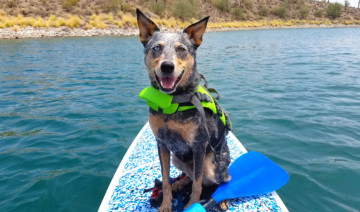A life jacket is essential safety equipment, even for four-legged swimmers. But how do you choose a dog life jacket that will fit your pet comfortably and keep them safe in the water?
Why Dogs Need Life Jackets
It is a misconception that all dogs are excellent swimmers. While most dogs do instinctively know how to paddle, different breeds are more adept in the water than others. In particular, dogs with very long or very short legs, very low or very high body fat, or less body strength may struggle more when swimming. Similarly, senior dogs or young puppies are not as agile in the water and can be at risk of drowning, as is any dog that may have joint or muscle injuries.
Even strong, healthy swimmers should wear life jackets, however. If a dog falls into the water unexpectedly, the shock and confusion could create swimming problems. Likewise, dogs could have difficulty swimming in challenging situations, such as over rapids or in extremely cold water. Even in perfect swimming conditions, a dog could become exhausted and struggle, but a life jacket can help them stay above water. Life jackets provide buoyancy, bright colors on the fabric help the animal remain visible even in dark or churning water, and built-in handles can help you get your dog out of the water safely and easily.
Choosing Your Dog’s Life Jacket
Whether you and your dog spend a lot of time boating or fishing, or you’re just planning a quick trip to the water, it is important to choose the right life jacket to keep your canine companion safe. Any time a dog is on, around, or near potentially dangerous water – lakes, rivers, oceans, or even the backyard pool for a weak swimmer – a life jacket is essential. When choosing a dog’s life jacket, consider:
- Size: Take your dog’s measurements carefully to get a life jacket of the proper size. The size around the chest, neck, and abdomen, as well as the dog’s weight, will all impact what size is best. The jacket should fit snugly but without chafing, and adjustable straps can help ensure the best fit for any pooch.
- Mobility: While a snug fit is essential for a life jacket, it should not fit so tightly that the jacket impedes the dog’s range of motion, especially for its head and legs, which could affect the animal’s ability to swim. If a dog’s legs or neck are restricted, the animal could panic in the water and may have even more difficulty swimming safely.
- Handle: A handle on the top of the life jacket, along the dog’s back, will make it easier to lift your dog out of the water and help it back onto a boat, pier, or bank as needed. Handles can also make it easier to provide your dog extra buoyancy if it is just learning to swim and you’re holding on to the jacket. Life jackets for larger, heavier dogs should have more than one handle for easier lifting.
- Color: Dog life jackets come in a variety of bright colors and fun prints. Choose a color that will be easily visible in different light conditions as well as when the jacket is wet or the dog may be struggling and splashing. This can help you locate your dog in the water in an emergency. Reflective strips or piping can also improve the jacket’s visibility.
- Foam Thickness: Thicker, higher-quality padding in a pet life jacket improves the buoyancy, which is especially critical for heavier dogs. The padding should be thickest at the sides and chest to keep the dog afloat comfortably, and a front floatation pad – which may be detachable – can help keep the dog’s head out of the water.
- Leash Attachment: While the life jacket is of most use in the water, a D-ring or other leash attachment can help it be useful on land as well. This is especially important for walking the dog along a dock, pier, or bank without needing to take the life jacket off and on repeatedly.
Getting Your Dog Used to a Life Jacket
Once you have found the perfect life jacket for your dog, it is important to get your pet used to wearing it comfortably or else the animal could panic in the water while wearing the jacket. First, leave the jacket out for the dog to sniff, and rub the jacket with their blanket or favorite toy to transfer some familiar, comfortable scent to the new jacket. If needed, allow the jacket to air out for several days to remove stronger “new” odors that could make your dog uneasy.
Next, try the jacket on your dog while indoors in a safe, comfortable setting. Be sure the animal is relaxed, and adjust any straps for the best fit. Allow the dog to wear the jacket for a few minutes to get used to the feel. Try a few training commands to encourage your dog to move around, lie down, and sit while distracting them with familiar behaviors and rewards. If the jacket has handles, lift your dog occasionally so they are used to the feeling, and try a short walk using the leash attachment.
Have the dog wear the jacket for longer periods each day for a few days before first wearing it in the water. Visit a safe, well-known water source first to be sure the jacket works well, and always supervise your dog while wearing the life jacket. Check the jacket’s fit each time it is worn, and inspect the jacket regularly for any signs of rips, tears, fraying, split seams, or other damage that could compromise its safety.
A life jacket may seem like a silly accessory for a dog, but it is essential safety equipment. By choosing the best life jacket for your dog and taking the time to get your pet used to wearing it, you will have a valuable tool for keeping your dog safe no matter what water fun you enjoy.






Comments